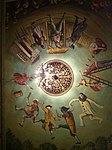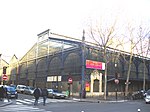Boulevard du Crime

The Boulevard du Crime was the nickname given in the 19th century to the Boulevard du Temple in Paris because of the many crime melodramas that were shown every night in its many theaters. It is notorious in French history for having lost so many theatres during the rebuilding of Paris by Baron Haussmann in 1862. Of the theatres on the boulevard, only the Folies-Mayer escaped demolition during the construction of Place de la République—solely because it was on the opposite side of the street.In spite of the name, the "Boulevard of Crime" was not dangerous or unpleasant. In fact, it was one of the most popular places in Paris. Every night more than 20,000 people came to walk, sing, laugh and have fun.The "Boulevard du Crime" is featured in the 1945 film Children of Paradise directed by Marcel Carné and gives its name to the first of two sections of the film.
Excerpt from the Wikipedia article Boulevard du Crime (License: CC BY-SA 3.0, Authors, Images).Boulevard du Crime
Boulevard du Temple, Paris 3rd Arrondissement (Paris)
Geographical coordinates (GPS) Address Nearby Places Show on map
Geographical coordinates (GPS)
| Latitude | Longitude |
|---|---|
| N 48.863288888889 ° | E 2.3665083333333 ° |
Address
Boulevard des Filles du Calvaire (Musée Picasso)
Boulevard du Temple
75003 Paris, 3rd Arrondissement (Paris)
Ile-de-France, France
Open on Google Maps










